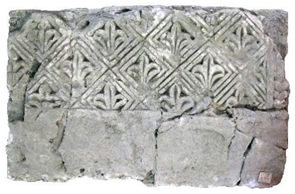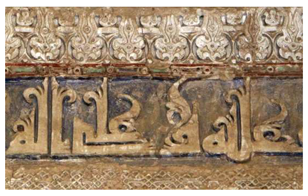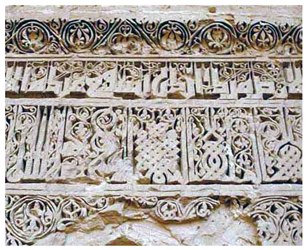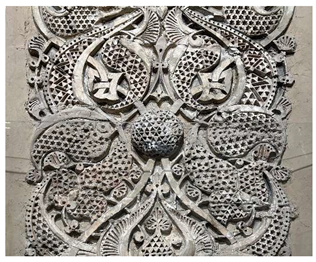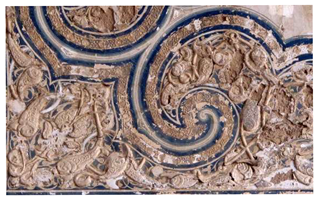Abstract
Ilkhanid architecture occupies a distinctive position in the history of Islamic art through the development of highly elaborate stucco decoration. Despite their technical and artistic significance, these works have seldom been examined with respect to execution methods and design principles. That gap is addressed here through a field identification and classification of the techniques and stylistic patterns characteristic of Ilkhanid stucco in Iran. The analysis reveals that Ilkhanid craftsmen introduced several innovative methods in hand-carved stucco, such as Seh-gacha (very high relief) and Moshabbak (reticulated forms), as well as a specialized molding technique (Patta), frequently enriched with gilding—the earliest documented use of gilding in Iranian architectural stucco. These findings challenge the prevailing view of Ilkhanid stucco as merely a continuation of earlier traditions, instead demonstrating its role as a medium of experimentation and innovation. Key stylistic features include multilayered arabesques combined with inscriptions of varying scales (exemplified by the Mādar-o Farzand style), gypsum-plastered surfaces adorned with knotted Kufic and Bannāī inscriptions, complex geometric frameworks, and the earliest known trefoil arch mihrabs and muqarnas-like stucco mihrabs. Together, these results highlight the Ilkhanid contribution to the technical and aesthetic evolution of Islamic architectural ornament during the 13th–14th centuries.
1. Introduction
A branch of the Mongol dynasty, later known as the Ilkhanids, ruled Iran between 1251 and 1355 CE. During this period, a distinctive architectural and decorative school emerged that developed established traditions while introducing important innovations [1]. Ilkhanid monuments are remarkable for their soaring proportions and inventive methods of space covering, while their decoration reveals the continued use of traditional materials—brick and stone in construction, and stucco for surface embellishment. Among these, stucco attained particular prominence; mihrabs, in particular, became part of a flourishing decorative art form distinguished by high relief [2,3].
Unlike molded traditions, such as those of Sāmarrā (style C) [4] or al-Andalus (e.g., the Alhambra1) [7], Iranian stucco was executed largely in situ through hand-carving (Dar-jā)2.
This distinction complicates scholarly analysis, especially when faced with layered compositions or very high-relief carving. Stucco decoration has a long history in Iran, with roots in the Sasanian period and possible antecedents in the Achaemenid use of painted plaster [8,9]. Sasanian examples reveal the early mastery of low- to medium-relief carving and geometric repetition, often covering friezes, imposts, and walls [10,11,12].
These traditions continued into the early Islamic period, where religious concerns curtailed figural representation3, with notable examples surviving in Nishapur and Naʿin. However, the Sassanid figural tradition was revitalized for some stucco figures of Royal Princes [17], despite the forbidden representation of human figures [13,17]. Scholarship has generally emphasized the influence of Abbasid Sāmarrā4 on these works, though Iranian examples often exhibit greater naturalism and refined detail, as seen in the “miniaturistic” 5 motifs of the 9th–10th centuries [18,21,22,23].
The Seljuq period marked a significant stage of innovation, with the introduction of a two-layered composition of thuluth inscription alongside Kufic and arabesque, as well as experiments in combining stucco with brick (extensively) and, rarely, tile [24]. Studies of monuments at Rayy, Ḥeydariya Madrasa, Ardestān Mosque, Malek Mosque of Kerman, and Robāṭ Sharaf highlight the increased plasticity and complexity of Seljuq stucco, which later shaped Ilkhanid developments [25,26]. Comparative analysis of Seljuq and Ilkhanid stucco mihrabs reveals a progression from simpler, repetitive geometric motifs to more complex forms integrated with vegetal patterns, reflecting the innovation of Ilkhanid artists while continuing prior traditions [27]. Stucco decorations were commonplace in Ilkhanid architecture, and they were even added to some parts of pre-existing buildings in this period, while some ornaments related to previous periods were restored, showing the prevalence and importance of this decorative art at that time [25].
Although some studies have catalogued stucco decorations [4,28,29,30,31,32], research remains fragmented on the Ilkhanid period. A few surveys of Persian stuccos identify general categories—such as “projection” versus “molding” techniques, including Moshabbak (reticulated) and Vaslehī (patchwork)—or emphasize recurring motifs such as lotus palmettes, rosettes, and manuscript-inspired Tezhib patterns [33,34,35,36]. Stylistically, a typical Ilkhanid high-relief style was identified, characterized by deep, projecting, and undercut reliefs achieved through complex techniques such as carving and multi-layering [33]. A few studies on the technical point of view on Iranian stucco have indicated that stucco decorations were executed in two ways: mainly in situ (Dar-jā) and occasionally prefabricated based on the pattern and the level of protrusion [37,38,39]. Yet the specific methods of execution remain largely unknown. The present study seeks to address specific features and identify the techniques that characterize Ilkhanid stucco, thereby distinguishing it from other periods.
Stucco has a particular importance because its stylistic features can serve as a primary evaluation for dating monuments. Four approaches are commonly employed to establish such stylistic idioms: (1) regional survey and patronage analysis, (2) attribution to specific workshops or masters, (3) tracing chronological development and hierarchy, and (4) identifying distinctive designs and techniques of each period. While a comprehensive study encompassing all these aspects exceeds the scope of a single article, this paper focuses on the last of these approaches by analyzing Ilkhanid-specific features and techniques of execution.
2. State of the Art
2.1. Main Features of Stucco Decorations Before the Ilkhanid
Stucco decorations of the Sassanid period are mainly hand-carved and include two main groups in terms of technique, the majority of which being (1) low- to medium-relief in dimension, such as the panels of Chal-Tarkhan and Kish remnants in the National Museum of Iran (NMI), and (2) sculpture, such as the horse of Nezam Abad in the Pergamon Museum of Berlin, Germany. Their stucco patterns are composed of (I) a single element (human, inscription, animal, and griffin) in a circular medallion with a turning wheel design (row of pearl), (II) a series of repeated elements symmetrically and rotatory enforced within a pearl band or ribbon, and (III) panels composed of interlocking and intersecting repeated elements or overlapping elements of circles of rosettes [40,41,42,43], all in a separated plane (Figure 1 and Table 1). Regarding designs, they enjoy a sort of rhythm with repetition of two or three motifs, creating new rhythms from simple ones where new motifs appear through repetition of primary motifs. It is clear that the Sassanid designers knew geometry based on rotational symmetry and synchronization of polar and rectangular geometry, and they knew how to transmit motifs by designing a quarter as a repeated unit [12].
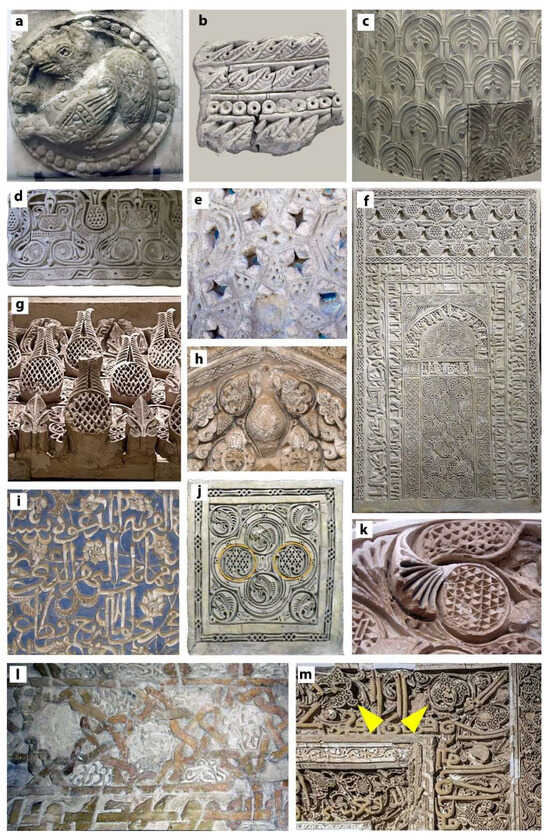
Figure 1.
Main features of stucco decorations before the Ilkhanid period (photos: A. Shekofteh): (a) circular medallion from Ctesiphon, American Museum of Natural History, New York; (b) fragment of a series of repeated elements framed within a pearl band, Chal-Tarkhan, NMI, Tehran; (c) reconstruction of a column from Tepe Hissar showing interlocking and intersecting repeated elements, Philadelphia Museum of Art; (d) repeated patterns in early Islamic stucco from Susa, similar to the Sāmarra style, with honeycomb piercings, NMI, Tehran; (e) combination of stucco with tile, Khwāja Atābak mausoleum; (f) single layer of low-relief mihrab of the Rayy Mosque, NMI, Tehran; (g) cornice panel from Tepe Madrasa, Nishapur, MMA, New York; (h) close-up of the mihrab of Naʿin Friday Mosque; (i) arabesque and Khatāʾī motifs integrated within thuluth calligraphy in Ḥeydariya Madrasa; (j) orange circles indicate two simple leaves decorated with honeycomb piercings (Āazhede-kāri), panel from Nishapur, NMI, Tehran; (k) close-up of Āazhede-kāri and Du-gacha leaf, Pa-Minar Mosque; (l) combination of stucco with brickwork, Barsiyān Mosque; (m) yellow arrows indicate Khatāʾī leaves decorated with Āazhede-kāri, lavishly ornamenting foliated Kufic, Jamaʿ Mosque of Zavāreh.

Table 1.
Summary of the stylistic evolution of stucco decorations in Iran from the Sasanian to the Safavid periods, based on previous studies.
Generally, the principles of the decorative design are based on repeating patterns and repetitive figural compositions during the Sassanid period and were continued in the early Islamic period of Iran. In addition, some remnants of the stucco decorations from the early Islamic period of Iran were designed based on late Sassanian–Umayyad and Sāmerra style B features, but also with typical elements such as stylized blooming lotus flowers and honeycomb piercings [23,44], indicating the progress of Islamic decoration during this time in Iran. The stucco decorations of this era are mainly in one layer of low relief (e.g., mihrab of Rayy Mosque in NMI) and, rarely, high relief in some specific elements, such as the fragment of a cornice panel from Tepe Madrasa (in the Metropolitan Museum of Art, MMA)6. It is known that Nishapur’s stucco collection was under the influence of the Sāmerra style or similar to the Merv and Samanid palace of Afrasiyab [23,42,45], but their method of execution is different in some cases, such as the so-called “Du-gacha”7 technique, which was used to shape high-relief motifs, such as the emboss part of a cornice panel from Tepe Madrasa was attached above the first layer. This unicum technique can be the starting point of very high-relief decorations that are used perfectly in decorations of the mihrab of Naʿin Friday Mosque from the Būyid (Figure 1). Moreover, spiral plants and rhythmic floral repetitions of the Sassanids were placed under a Kufic inscription—“foliated Kufic”8—during the early Islamic period. The changes in the stucco techniques before the Seljuq period, as seen in Du-gacha and foliated Kufic, caused an improvement in Seljuq decorations in terms of their techniques and designs [25]. The mihrab of Ḥeydariya Madrasa stands as a remarkable example of this technical and artistic refinement.
The conceptual idiosyncrasies of Seljuq stuccos have been divided into four groups, including (1) motifs set in dense and centralized compositions on a single plane, with the large-scale motifs always punctured by various geometric patterns of the so-called honeycomb piercings, “Āazhede-kāri”9; (2) flat and static compositions, which were replaced by various further motifs that are set on a different, superimposed second plane consisting of vegetal elements; (3) lavishly decorated inscriptions with thuluth added to the Kufic with a second layer of vegetal elements; (4) innovative embellishments, including the extensive combination of stucco and brickwork, as seen in the Golpāyegān Jamaʿ Mosque10 and the Sin and Barsiyān Mosques; and more rarely, the combination of stucco with tile, exemplified by the unique case of the Khwāja Atābak mausoleum (Figure 1) [49,50].
On the other hand, from an evolutionary viewpoint, Seljuq stucco decorations are divided into three stages of development: (I) inspired by Sassanid style features, such as interlocking and intersecting repeated elements, or human and animal figures; (II) inspired by the style of early Islamic decorations, such as spiral plants with simple leaves decorated by Āazhede-kāri; (III) an innovative new ornament method of forming arabesques and “Khatāʾī”11 within calligraphy, wherein Khatāʾī or leaves are decorated with Āazhede-kāri in a single-plane inscription (Figure 1 and Table 1). Some motifs are in high-relief and consequently shaped in two layers (Du-gacha) [25]. The third stage is the one that can be enumerated as the specific Seljuq stucco decorations at the end of the dynasty.
During the Seljuq period, regional workshops generated a rich diversity of decorative approaches, producing a dynamic corpus that directly informed later Ilkhanid innovations [26]. These developments encouraged greater formal variety, more intricate pattern systems, and a sophisticated interaction between inscriptions and ornaments. As a result, Seljuq stuccos reached an unprecedented level of plasticity, influencing the structural decoration of mihrabs not only within Iran but also in Islamic religious buildings as far afield as Egypt and Syria during the fifth–sixth/eleventh–twelfth centuries [51].
2.2. Stucco Decorations of the Ilkhanid
During the Ilkhanid period, stucco decoration became a primary monumental decoration. All motifs and techniques from past periods were common. The main distinction of Ilkhanid stucco decorations compared with previous periods is their magnificently elaborated mihrabs. Generally, in addition to the mihrab, maqṣura was decorated as well, often by the so-called “Qaṭār-bandy”12; the inscriptions are Kufic or mainly thuluth. Moreover, walls of maqṣura were completely covered by stucco decorations, and in some cases, a combination of brick and stucco was used, such as the Jamaʿ Mosque of Varāmīn (Figure 2). Ilkhanid mihrabs are known as having soaring heights, such as those of the Urmia Jamaʿ Mosque (7.82 m), Pir-i Bakrān mausoleum (6.5 m), Jamaʿ Mosque of Faryoūmad (5 m), Jamaʿ Mosque of Varāmīn (approx. 8 m, as 3 m of it has been destroyed), and Jamaʿ Mosque of Oshtorjān (7 m); in fact, mihrabs of the Ilkhanid period, depending on their importance, are different in size. For example, the outdoor mihrab of Kermānī Mosque (2 m) from the Shaykh-i Jām complex and the small mihrab on the second floor of the Pir-i Bakrān mausoleum (1.50 m) are not that high; their numbers are few, however [52]. All mihrabs are rectangular in shape and mainly include “Pishāny”13 (frieze), lunette, spandrel, columns, and margin inscriptions (Figure 2). In general, the high mihrabs are composed of two levels, including two lunettes above each other, being flanked by two columns [33].
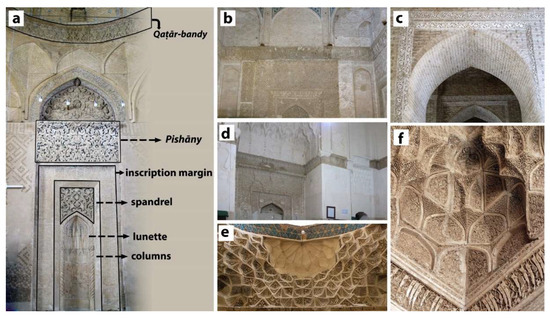
Figure 2.
General features of Ilkhanid stucco decoration (photos: A. Shekofteh): (a) rectangular frame of Jamaʿ Mosque of Oshtorjān showing Qaṭār-bandy, Pishāny, lunette, spandrel, columns, and marginal inscriptions; (b) stucco Qaṭār-bandy inscription and maqṣura walls of Jamaʿ Mosque of Varāmīn; (c) combination of stucco and brick decorating the iwān walls of Jamaʿ Mosque of Varāmīn; (d) Qaṭār-bandy inscription of the Kermānī maqṣura, Shaykh-i Jām complex; (e) stucco muqarnas, Bayazid-i Basțami complex; (f) stucco muqarnas of Jamaʿ Mosque of Faryoumad.
In addition to the mihrab and maqṣura, outdoor stucco decorations were prevalent in the Ilkhanid monuments; e.g., the iwāns of the Jamaʿ Mosque of Faryoumad and that of the Bayazid-i Basțami complex are decorated with stucco muqarnas (Figure 2).
Studies on Ilkhanid stucco decoration indicate a high level of complexity and diversity in combining geometric and vegetal motifs, frames, and inscriptions [23]. The ornamental features of the mihrab from the Jameʿ Mosque of Sāveh highlight a representative example of the integration of vegetal and geometric motifs in Ilkhanid mihrabs and emphasize the importance of harmony between calligraphy and intricate arabesques [53]. Similarly, research on the geometric decorations of the Solṭāniyya dome and the Jameʿ Mosque of Varāmīn demonstrates that geometry in Ilkhanid stucco served not only aesthetic purposes but also spatial and symbolic functions [54,55].
In terms of design, plant patterns, geometric forms, and inscriptions are the dominant features of Ilkhanid stucco decoration (Table 1). Low-relief plant motifs, including large-scale arabesque elements, were often combined with geometric patterns. As in Seljuq design, arabesques were frequently employed in the background of inscriptions. Most compositions are complex and highly elaborate [23,27]. Ilkhanid arabesque motifs can be divided into two principal types—spiral and mainly scroll forms—while their overall compositions fall into two categories: symmetrical and asymmetrical. Symmetrical compositions are identified through several methods of repetition, including reflection, rotation, inversion, and translation. Asymmetrical compositions, by contrast, are structured according to the visual value and balance of individual elements [56].
These findings on Ilkhanid stucco decoration are valuable for understanding design; however, from the perspective of the present research, it is equally necessary to identify the principal features and specific techniques of Ilkhanid stucco, given the current lack of scholarly familiarity. For this purpose, a selection of major Ilkhanid monuments containing significant stucco decoration—or that were redecorated during the Ilkhanid period—has been investigated (Table 2 and Figure 3). It should be noted that Ilkhanid stucco decoration is found across a wide range of monuments throughout Iran, including mosques, mausolea, and Imamzādehs. In the scope of this study, the functional type of the building is not considered relevant; rather, the focus is directed exclusively toward the most technically and aesthetically sophisticated stucco decoration.

Table 2.
The most important monuments, including significant stucco decorations, from the Ilkhanid period in Iran.
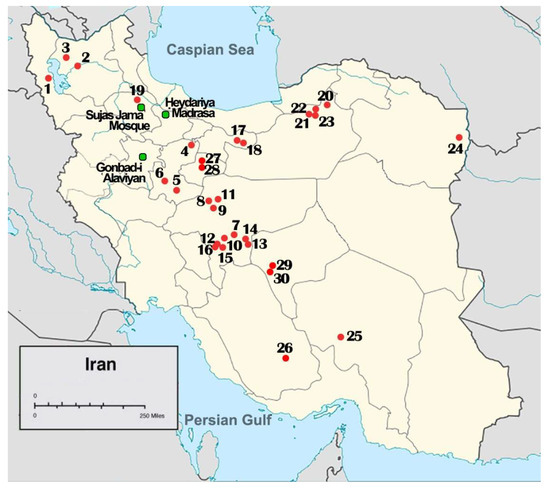
Figure 3.
Distribution of the buildings in a map of Iran: red spots show the number of buildings in Table 2; green spots show the location of the case studies and the relevant place.
3. Methods
This study is based on a comparative stylistic and technical analysis of stucco decorations from Ilkhanid monuments in Iran, with supplementary references to earlier and later periods for contextual evaluation. This research combined direct field observations, photographic documentation, and a detailed literature review in order to establish diagnostic criteria for Ilkhanid stucco techniques and ornamental idioms.
The analysis focused on a selected group of representative monuments with surviving stucco programs, including mosques, mausolea, and Imamzādehs. Fieldwork involved systematic photographic recording of architectural surfaces, focusing on mihrabs, friezes, lunettes, wall panels, and transitional structural zones where stucco ornaments are typically concentrated. Photographs were taken with attention to relief depth, layering, and material junctions. Selected motifs were digitally enhanced through colorized line drawings to clarify superimposed layers and construction methods. A typological framework was developed to categorize both techniques and design idioms. Each decoration was assessed according to the presence, absence, and degree of development of these characteristics. The frequency of identified features was then compared across monuments to establish correlations with Ilkhanid style and distinguish it from other periods.
Chronological and regional variations were assessed by comparing monuments from northern Iran (e.g., Tabriz, Solṭāniyya, Qazvin) with those of Greater Khorasan (e.g., Faryoūmad, Basțām) and central Iran (e.g., Isfahan, Yazd, Kerman). This allowed the study to account for workshop traditions and regional stylistic divergences. Inscriptions were further examined for script type, scale, placement, and integration with surrounding motifs. As many monuments have undergone restoration or partial destruction, some findings rely on published photographs, previous surveys, and secondary scholarship. When possible, these were cross-checked with surviving physical evidence. No invasive or material–scientific tests were conducted; instead, the study is based on visual–analytical and stylistic methodologies.
4. Findings and Discussion
4.1. Techniques of Ilkhanid Stucco Decorations
With regard to techniques of shaping stucco during the Ilkhanid period, decorations can generally be categorized by relief: low relief, high relief, and very high relief. Methods of execution fall into two main groups: (I) hand-carved and (II) molding. “Molded” work, which rarely appears in high relief, could be produced either in situ (directly on the surface) or as prefabricated panels [35]. Although this typology appears straightforward, the technical processes involved are considerably more complex, and scholarly interpretations of these categories have sometimes been inconsistent. For example, Grbanovic has argued that the stucco decorations of the Pir-i Bakrān mausoleum were composed of gypsum mixed with talcum powder and executed in a technique known as killed plaster (gach-i koshta). In this method, craftsmen worked in successive layers and had approximately 48 h to carve the material before it hardened. She further suggested that this technical limitation accounts for the preference for small, elaborately worked panels, as opposed to larger panels requiring greater executive skill, within the restricted working time [4].
In practice, Iranian stucco techniques are more intricate than their conventional terminology implies. The base layer applied over the construction surface, or substrate, comprises gypsum and clay, a mixture known as gach-o-khāk14. Above this, a render layer provides a solid foundation for subsequent coats. In some cases, gach-i koshta (gach-e koshteh) is applied as a fine finishing coat to slick the surface, preparing it for the outermost layer, which is typically no more than 0.5 cm thick [38]. This mixture likewise contains no talcum. Gach-i koshta is a preparation method by mixing gypsum powder with water differently, not a materials combination [57]. It should be noted, however, that gypsum can naturally contain a high proportion of clay minerals as impurities—such as those found in gypsum resources from Yazd—and these may also appear in gach-i koshta, contrary to the occasional assumption that talcum was added as an additive.
Carving requires a quick-setting gypsum known as gach-i tīz15. The first carving layer with gach-i tīz typically establishes the background. This process defines the low-relief technique, or Yek-gacha16. For high-relief stucco, a more viscous subsequent layer with a cream-like consistency—known as gach-i khvosh-māya17 [58]—is applied in what is termed the Du-gacha technique (Figure 4). Its higher water content prevents premature drying when laid over gach-i tīz and facilitates easier shaping. This layer produces the high-relief effect by adhering more firmly to the underlying surface. Finally, a third layer, “Seh-gacha”18, was rarely employed to create very high-relief; this mixture has a consistency similar to gach-i tīz. Contrary to popular belief, all these layers consisted of nearly pure gypsum without added materials.
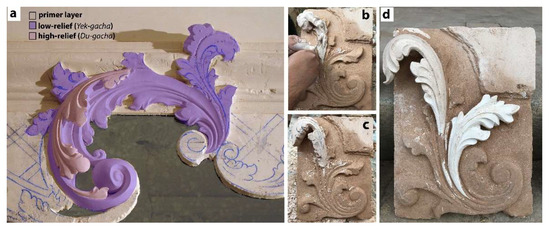
Figure 4.
Layered technique (photos: A. Shekofteh): (a) three layers of stucco decoration in a contemporary stucco workshop, Azmoon, Isfahan; (b) Du-gacha technique illustrated using two different colors to distinguish layers—cream-like viscosity of the gypsum paste is used for the second layer; (c) carving process after the initial setting of the gypsum paste; (d) low-relief undercut stucco in brown, and high-relief stucco in the second layer in white.
Thus, all types of hand-carved (non-molded) stucco techniques can be classified into three main groups according to their dimensionality and method of execution: (1) low relief (Yek-gacha), (2) high relief (Du-gacha), and (3) very high relief (Seh-gacha). Each category is prepared through distinct procedures. Yek-gacha, described by stucco craftsmen “Ostādkārān”, refers to decoration formed from a single plaster layer, typically consisting of semi-flat or shallow-relief motifs with a depth not exceeding 0.5–2 cm. This technique represents one of the earliest methods of stucco carving, with roots traceable to the Sasanian period, where designs were executed against a cut-away background. Yek-gacha remained in use from the early Islamic period through the contemporary period. In Ilkhanid architecture specifically, it was employed primarily for the base of stucco or wall decorations, including “Kaluk-band”19 and brick-like cladding of “Shebh-i Ājori”20 (Figure 5).
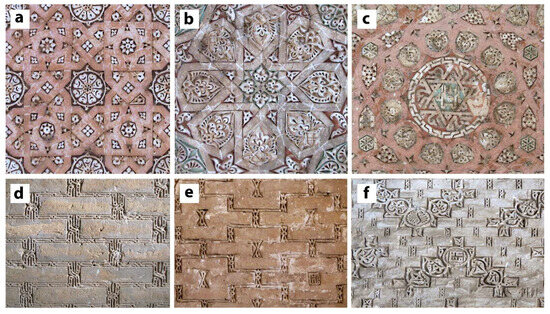
Figure 5.
Simple techniques of Yek-gacha (photos: A. Shekofteh): (a–c) low-relief technique in geometric patterns from Solṭāniyya dome; (d) Kaluk-band of Solṭāniyya dome; (e) Kaluk-band of Sāveh Jamaʿ Mosque; (f) brick-like cladding “Shebh-i Ājori” patterns from Jamaʿ Mosque of Varāmīn.
Du-gacha refers to the creation of high-relief motifs using two layers of plaster: the first, with a medium, honey-like viscosity, forms a semi-flat relief, while the second, more viscous layer (cream-like) builds individual high-relief elements that adhere securely to the first layer, typically reaching no more than 5 cm in height (Figure 4). This technique is not specific to the Ilkhanid period, but during this period, Du-gacha was employed to produce both relief and high-relief patterns, most often in superimposed layers of motifs on mihrabs, as seen in the Haft Shūya Mosque and the Urmia Jamaʿ Mosque (Figure 6).
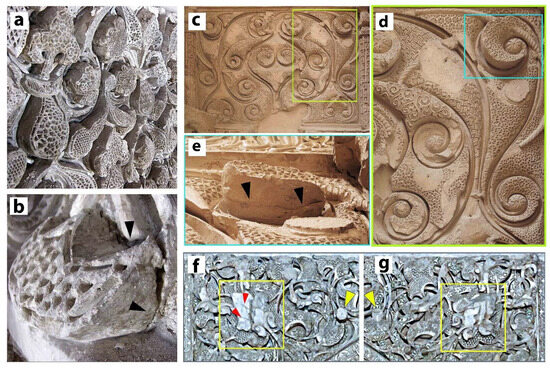
Figure 6.
Sophisticated stucco techniques of Du-gacha and Seh-gacha (photos: A. Shekofteh): (a) high-relief technique from Urmia Jamaʿ Mosque; (b) detail of a motif from Urmia Jamaʿ Mosque, with black arrows indicating the junction line between two layers; (c) Du-gacha technique from Pir-i Bakrān mausoleum; (d) magnified view of the yellow rectangle in (c); (e) detail of the blue rectangle in (d), with black arrows showing the junction line of the second layer; (f,g) spandrels of the mihrab of Jamaʿ Mosque of Varāmīn: the square in (f) highlights the second layer, with red arrows marking drawing guidelines and a yellow arrow showing the remnant of a third (Seh-gacha) layer; the square in (g) shows remnants of the third layer, with the yellow arrow indicating a destroyed portion of it.
Seh-gacha appears exclusively in Ilkhanid stucco decoration. This technique involves the addition of an extra plaster layer to create very high-relief motifs, typically exceeding 5 cm in depth and, in some cases, reaching up to 15 cm, applied to small elements such as the lanceolate leaves of Khatāʾī. Motifs were thus designed in three superimposed layers, with the uppermost plane normally formed in very high relief (third plaster layer) (Figure 6). The technique was primarily employed in lunettes and the upper panels of mihrabs, known as Pishāny. Notable examples include the Pishāny of the Pir-i Bakrān mausoleum, one of the most outstanding Ilkhanid stucco decorations, and the mihrab of the Jamaʿ Mosque of Varāmīn, which also demonstrates superimposed layering achieved through the Seh-gacha technique (Figure 6). In terms of design in these cases, the first layer is typically composed of arabesque motifs, the second layer features floriated with Khatāʾī, and the third consists of inscriptions, primarily curved Bannāī. In some instances, a fourth layer of arabesques incorporates isolated Khatāʾī motifs.
In addition to the hand-carving techniques described above, two further methods were employed during the Ilkhanid period: Patta (molded) and Moshabbak (reticulated). The gilding technique also appeared for the first time to embellish stucco decorations in major monuments such as the Solṭāniyya dome [34] and the Pir-i Bakrān mausoleum [39] (Figure 7). Notably, gilding was often applied simultaneously to tiles, such as “lajvardina” [59].
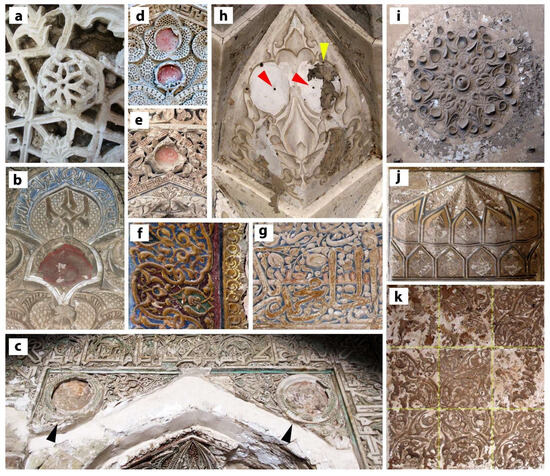
Figure 7.
Specific decorations (photos: A. Shekofteh): (a) reticulated decorations, Moshabbak, of Urmia Jamaʿ Mosque; (b) destroyed Moshabbak of Pir-i Ḥamze Sabzpūsh and the red color beneath it; (c) destroyed Noquls of the Ilkhanid mihrab of Sāveh Jamaʿ Mosque (black arrows)—its background has been painted in red; (d) red part under destroyed Moshabbak of Haft Shūya Mosque; (e) destroyed Moshabbak of Pir-i Bakrān mausoleum painted in red; (f) gilded stucco of Solṭāniyya dome; (g) gilded inscription of Pir-i Bakrān mausoleum; (h) “Patta” on a concave of the muqarnas of Solṭāniyya dome—the red arrows show the nails, and the yellow arrow indicates torn and hanged fabric; (i,j) the molded stucco decorations of Shams al-Din mausoleum; (k) molded stucco decoration of Rokn al-Din mausoleum—the dashed lines show the interface of molded decorations.
Patta is a prefabricated molding method. Its construction involves layering fabric on the base, followed sequentially by an adhesive (e.g., fish glue); gypsum; additional adhesive layers; paper; a preparatory layer; and, finally, gilding [60]. The technique requires a wooden mold with negative motifs, which is pressed onto the prepared plaster via the paper layer. The first documented use of Patta occurs in the Solṭāniyya dome [61], where twelve large, separate Toranj panels were mounted with nails on the dome’s ceiling. Additional Patta panels are found on the concave surfaces of its muqarnas, corresponding to the second decoration phase (1325–30) of Solṭāniyya (Figure 7). Solṭāniyya represents the most elaborate early fourteenth-century building in Iran [2], commissioned by the Ilkhanid court, and it is likely that its decorative techniques served as prototypes for subsequent works. This molding method was later adopted in Muẓaffarid monuments in Yazd, including the Rokn al-Din Mausoleum and Shams al-Din Mausoleum, with minor adaptations—for example, some panels were molded directly onto the wall [34,62].
Reticulated decoration, or Moshabbak, is another technique employed in Ilkhanid stucco. Initially, reticulated motifs appeared as small elements in lunettes of mihrabs, placed alongside embossed motifs. The mihrab of Pir-i Ḥamze Sabzpūsh21 and the Jamaʿ Mosque of Neyriz22 are likely the earliest examples of reticulated stucco decoration. Subsequently, mihrabs such as those of Yahya va Fażl-al-Reżā23, Haft Shūya Mosque, Pir-i Bakrān, Uljāytu (Jamaʿ Mosque of Isfahan), and Faryoūmad were also adorned using the Moshabbak technique.
In general, this method involves carving intricate shapes atop the main floriated motifs or in the center of a lunette composition, often with the background painted red. The Moshabbak technique is also applied to the both sides—left and right—of mihrab’s spandrel, a feature known as Noqul24 (Figure 7).
The combination of different materials within a single composition represents another significant decorative technique of the Ilkhanid period. As noted above, the integration of brickwork with stucco was already well established during the Seljuq era, with outstanding examples in the Bārsiyān and Golpāyegān Jameʿ Mosques. The combination of stucco and tile, however, appears to have been first experimented with in the mausoleum of Khwāja Atābak in Kerman during the Seljuq period, but it was only in the Ilkhanid era that the technique was employed on a larger and more sophisticated scale. Notable examples include the Pir-i Bakrān mausoleum, where the combination was realized in geometric arrangements, and the Jameʿ Mosque of Oshtorjān, where it was used in a distinctive manner, most prominently in a Muʿarraq25 inscription executed in tile against a floral stucco background (Figure 8). The distribution of Ilkhanid stucco techniques across major monuments is summarized in Table 3.
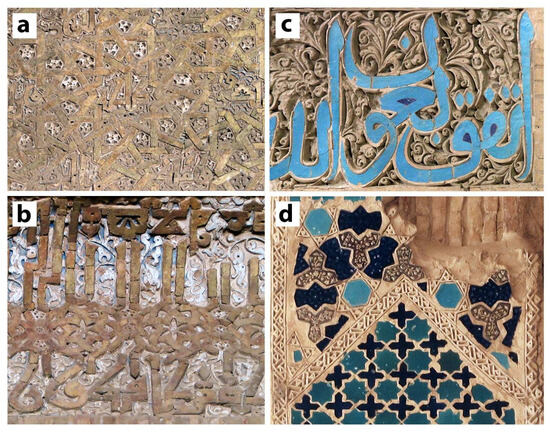
Figure 8.
Combination techniques (photos: A. Shekofteh): (a) the combination of brickwork and stucco in a geometric pattern from Jamaʿ Mosque of Barsiyān; (b) the combination of brickwork and stucco in a Kufic inscription from Jamaʿ Mosque of Golpāyegān; (c) the combination of stucco and tile from Jamaʿ Mosque of Oshtorjān; (d) a geometric combined technique of tile and stucco, Pir-i Bakrān mausoleum.

Table 3.
The dispersion of stucco techniques of the Ilkhanid in the monument of Table 2.
4.2. Design Elements and Compositions of Ilkhanid Stucco Decorations
During the Ilkhanid period, geometric patterns appeared both as independent compositions—on columns and the margins of mihrabs—and in combination with inscriptions and floral ornaments [70]. These patterns were widely employed, often recalling the Āzhede-kārī of the Seljuq period, which incorporated repetitive geometric designs to elaborate larger motifs. Ilkhanid craftsmen, however, introduced new refinements, such as embedding intricate, small-scale geometric motifs within larger geometric elements (Ālat), a technique known as Shāh-gereh.
The Āzhede-kārī of this period generally relied on three- and six-point bases [27], while single geometric compositions were typically placed in the arches of side walls, most often structured around six- or eight-point bases arranged within grids of squares and triangles (Table 4). Basic six- and eight-point patterns, though considered simple in Islamic architecture of the late ninth century26 [71], became fundamental to the increasingly complex geometric designs of Iran. A notable example of Ilkhanid stucco geometry survives in the Imamzadeh Yahyā at Varāmīn, where individual geometric squinches are integrated with floral Khatāʾī motifs. In this case, a distinct geometric grid was devised for each floral design. Similarly, the vaulted ceilings of the third story of the Solṭāniyya dome were each once adorned with a unique geometric framework, comparable to the blind arcades of the Jamaʿ Mosque of Faryūmad (Figure 9).

Table 4.
Significant geometric patterns of the Ilkhanid stucco decoration.
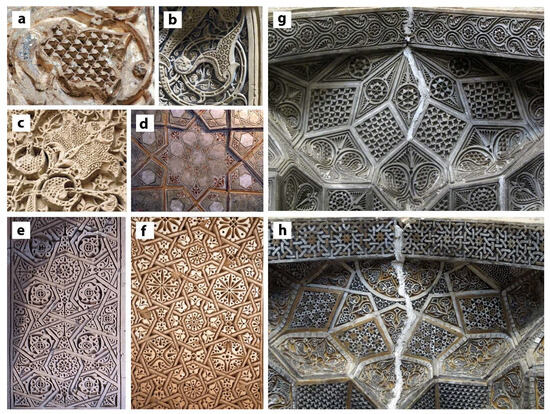
Figure 9.
Geometric ornaments (photos: A. Shekofteh): (a) Āzhede-kāri of Jamaʿ Mosque of Faryoūmad; (b) Āzhede-kāri of Jamaʿ Mosque of Oshtorjān; (c) Āzhede-kāri of Pir-i Bakrān mausoleum; (d) geometric pattern of Solṭāniyya dome; (e,f) geometric patterns of Jamaʿ Mosque of Faryoūmad, decorated with Khatāʾī; (g,h) a variety of geometric patterns of Imamzadeh Yahya-i Varāmīn.
Another defining feature of Ilkhanid stucco decoration is the extensive use of inscriptions. During this period, a wide range of scripts was employed, including Bannāī27; Reqāʿ28; and, in certain cases, thuluth, alongside various forms of Kufic. A distinctive Ilkhanid variant of thuluth, known as Mosalsal, was introduced, for example, in the mihrab inscription of Kermānī at the Shaykh-i Jām complex.
Kufic inscriptions embellished with vegetal ornament—commonly referred to as foliated or floriated Kufic—were widespread. Braided Kufic, or “knotted Kufic,” became a hallmark of the Ilkhanid period and was prominently used in the mihrabs of the Jamaʿ mosques of Isfahan, Faryūmad, and Basṭām, with an especially elaborate example surviving in the Jamaʿ Mosque of Urmia (Figure 10).
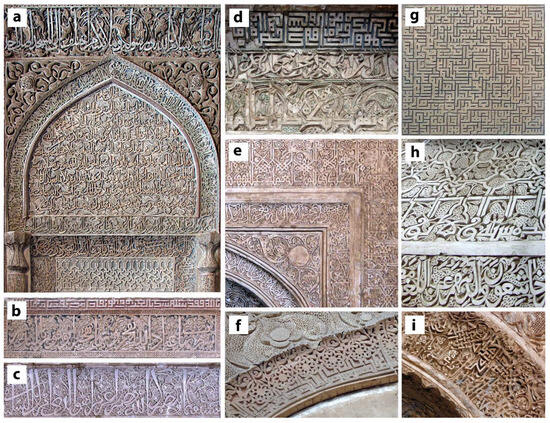
Figure 10.
Inscriptions (photos: A. Shekofteh): (a) mihrab of Jamaʿ Mosque of Isfahan, showing an inscription based design; (b) thuluth inscription of Pir-i Bakrān mausoleum; (c) the Ilkhanid thuluth, Mosalsal, in Kermānī mihrab of Shaykh-i Jām complex; (d) three lines of inscriptions of Sāveh Jamaʿ Mosque, from bottom to top: foliated and floriated Kufic, thuluth oriented to Tawqiʿ, Bannāī; (e) braided Kufic in the mihrab of Jamaʿ Mosque of Basțām; (f) floriated Kufic of Pir-i Bakrān mausoleum; (g) Bannāī inscription of the Pir-i Bakrān mausoleum; (h) Reqāʿ inscription at the bottom and knotted Kufic at the top, Urmia Jamaʿ Mosque; (i) braided Kufic in the mihrab of Jamaʿ Mosque of Faryoūmad.
A further innovation was the juxtaposition of inscriptions in two different scales within a single frame, a practice known as Mādar-o Farzand (“mother and child”), in which the lower band is typically larger, and the upper one smaller. Examples can be found in the Solṭāniyya dome, the Pir-i Bakrān mausoleum, and the Jamaʿ Mosque of Varāmīn. Rarely, three lines of inscription were combined in a single frame, as in the mihrab of the Jamaʿ Mosque of Oshtorjān, where the smallest line is painted in blue rather than carved, and in the Jamaʿ Mosque of Abarqū, where the third line is executed in Bannāī (Figure 11). Mādar-o Farzand compositions generally consist of two Kufic inscriptions, or a combination of Kufic and thuluth, with the third line occasionally rendered in Bannāī. These complex designs testify to the ingenuity of Ilkhanid calligrapher–craftsmen.
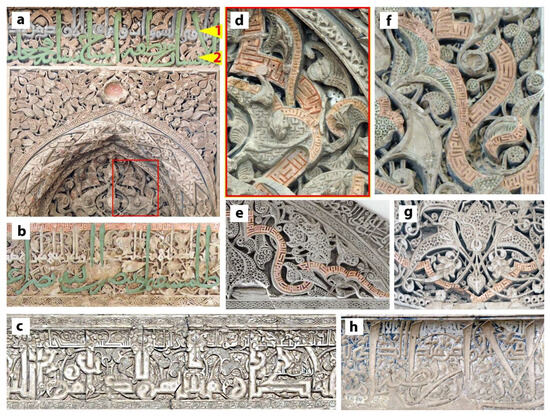
Figure 11.
Specific inscriptions (photos: A. Shekofteh): (a) Mādar-o Farzand inscription of mihrab of Pir-e Bakrān mausoleum, (1) Kufic in small size, (2) thuluth in large scale; (b) three lines of inscriptions within each other of Jamaʿ Mosque of Abarqū: thuluth (green), Kufic (white), and Bannāī (peach); (c) Mādar-o Farzand inscription of Varāmīn mihrab; (d) detail of red rectangle of (a), a combination of curved Bannāī with floral ornaments in peach color; (e) combination of curved rows of Bannāī with floral patterns in peach color, Fār Fān Mosque; (f) combination of Bannāī with floral patterns in peach color, Jamaʿ Mosque of Oshtorjān; (g) combination of Bannāī with floral patterns in peach color, Jamaʿ Mosque of Abarqū; (h) three intertwined rows of different inscriptions from the Jamaʿ Mosque of Oshtorjān—the third row of inscription is in a white color with a blue background.
Finally, Bannāī inscriptions were extensively employed on side walls of mihrabs in brick-like patterns, as well as within mihrab decoration, either independently or in combination with floral motifs arranged in curvilinear layouts. Notable examples include the Pir-i Bakrān mausoleum, Jamaʿ Mosque of Abarqū, Fār Fān Mosque, Haft Shūya Mosque, and Sāveh Jamaʿ Mosque (Figure 11).
In addition to advances in geometric and epigraphic ornament, vegetal motifs—particularly arabesques and Khatāʾī—were further developed during the Ilkhanid period. Compared with earlier traditions, these designs became increasingly sophisticated from the outset of the dynasty. They were typically composed of flowing arabesques arranged in perpetual waves, superimposed with Khatāʾī floral motifs, and in some cases augmented by Bannāī inscriptions applied as a secondary layer in the background. Such complex, multi-layered compositions can be seen in the mihrabs of the Marand Jamaʿ Mosque, the Jamaʿ Mosque of Varāmīn, and the Pir-i Bakrān mausoleum, where the intricacy of the patterns is so pronounced that redrawing them poses considerable challenges (Figure 12). In these works, the addition of multiple layers of motifs corresponded directly to an increased depth of relief, progressively projecting the decoration from background to foreground.
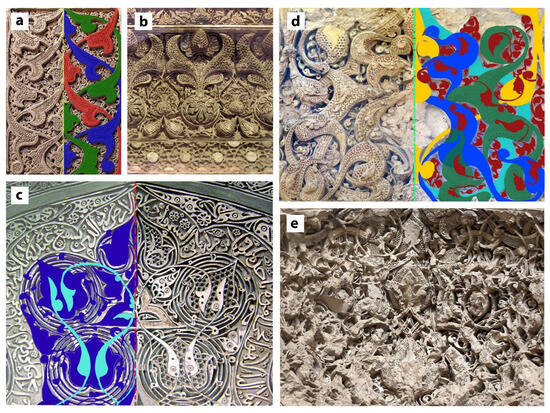
Figure 12.
Layered stucco designs (photos: A. Shekofteh): (a) three interlaced scrolls (perpetual wave) within a frame from the Pir-i Bakrān mausoleum, each scroll is shown in a different color; (b) superimposed layers of floral motifs from the Jamaʿ Mosque of Isfahan; (c) mihrab of the Bayazid-e Basțāmi complex, showing two layers of ornament on the right side: a dark blue Khatāʾī background (Sar Band) with spiral rolls, overlaid by turquoise arabesques in the foreground; (d) frieze of the mihrab of the Pir-i Bakrān mausoleum—a colorized drawing on the right illustrates four superimposed layers of floral motifs (in green, blue, red, and yellow) plus one Bannāī layer (turquoise blue); (e) lunette of the Jamaʿ Mosque of Varāmīn, where a highly intricate composition reveals multiple carved layers of stucco floral ornament.
New ornamental elements were introduced into Ilkhanid stucco decoration. For example, pairs of spiraling, twisted columns were placed on either side of the mihrab, as in the Pir-i Bakrān mausoleum, the Jamaʿ Mosque of Oshtorjān, and the Jamaʿ Mosque of Abarqū, where the twisted spiral (wreathed) columns converge at the apex of an arch (Figure 13). In some cases, however, the flanking half-columns were decorated not with the conventional rope pattern but with geometric motifs, as in the mihrab of Rabiʿa Khātūn-i Oshtorjān at NMI.
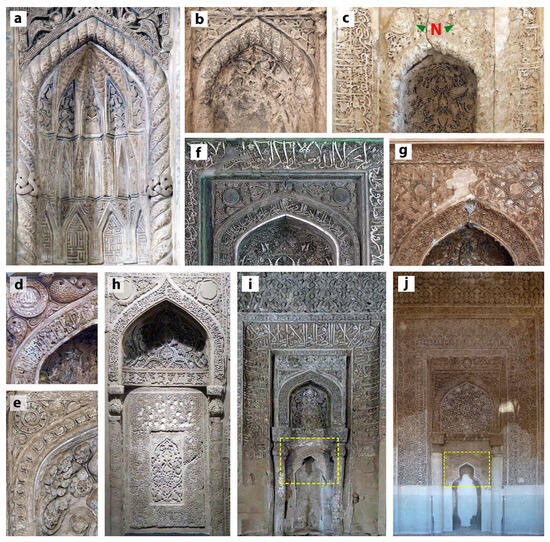
Figure 13.
New elements of design (photos: A. Shekofteh): (a) mihrab of Jamaʿ Mosque of Oshtorjān, spiral columns, and its muqarnas lunettes; (b) spiral columns of mihrab of Pir-i Bakrān mausoleum; (c) spiral columns of mihrab of Jamaʿ Mosque of Abarqū—its two Noquls (N) are indicated by green arrows; (d) Noquls of the Imamzadeh Nūr mihrab that include “الله”; (e) Noquls of the mihrab of Naʿin Friday Mosque decorated with spiral plant; (f) Noquls of the mihrab of Bayazid-e Basțāmi complex; (g) Noquls of the mihrab of Jamaʿ Mosque of Faryoūmad (h) small niche flanked by engaged columns—top: destroyed Noquls of the mihrab of Rabiʿe Khātūn-i Oshtorjān, bottom: semi-columns designed with geometric patterns; (i) trefoil lunette of the Marand Jamaʿ Mosque; (j) trefoil lunette of the mihrab, Urmia Jamaʿ Mosque.
Another innovation of the period was the introduction of the trefoil arch in stucco mihrabs, the earliest example likely being that of the Urmia Jamaʿ Mosque (1276), followed by those of the Marand Jamaʿ Mosque (1330–1331) and Kāshān Jamaʿ Mosque (fourteenth century). A further distinctive development was the incorporation of muqarnas into the lunette zone of stucco mihrabs. Although muqarnas-like decoration had appeared earlier in brickwork—for instance, in the Seljuq-period Barsiyān Jamaʿ Mosque—the Ilkhanid period witnessed the first systematic use of gypsum muqarnas lunettes, with the Oshtorjān Jamaʿ Mosque (1315) representing the earliest surviving example of this type.
The design known as Noqul, widely employed in the spandrels of Ilkhanid mihrabs, was one of the most characteristic motifs of this period. The origins of Noqul can be traced back to the mihrab of the Friday Mosque of Naʿin from the Būyid period, where it consisted of spiral vegetal forms. This motif continued into the Seljuq period, appearing in stucco mihrabs such as those of Robat Sharaf, Imamzadeh Nūr, and the Sāveh Jamaʿ Mosque (attributed to the early Seljuq period [72]). Despite this continuity, differences in design are notable: the Noquls of Robat Sharaf consist solely of spiral arabesques, whereas those of Imamzadeh Nūr and the Sāveh Jamaʿ Mosque are filled with inscriptions of “الله.”
By contrast, Ilkhanid Noquls exhibit a consistent preference for geometric reticulated designs, generally executed against a red background. Notable examples include the Rabiʿa Khātūn-i Oshtorjān, the second mosque mihrab of the Bayazid-i Basțāmī complex, the Basțām Jamaʿ Mosque, and the Sāveh Jamaʿ Mosque (Figure 7; Figure 13). The distribution of such Ilkhanid stucco features is summarized in Table 5.

Table 5.
The dispersion of stucco features of Ilkhanid design.
4.3. Stylistic Features of Ilkhanid Stucco Decorations
The creation of Ilkhanid stucco decorations was conditioned by several interrelated factors. First, the abundance of gypsum resources across Iran provided craftsmen with a readily available and inexpensive material, encouraging its widespread use and facilitating technical experimentation. Stucco is lightweight, versatile, and adaptable to both carving and casting, and allows artisans to execute complex motifs and large decorative programs with relative ease. In addition, religious considerations shaped the choice of ornament: stucco offered a highly suitable medium for embellishment in accordance with Islamic sensibilities while still permitting symbolic richness through vegetal, geometric, and epigraphic designs. At the same time, the Ilkhanid rulers sought to demonstrate imperial authority and cultural distinction by surpassing Seljuq precedents with more sophisticated forms, such as multilayered arabesques, very high relief (Seh-gacha), and innovations in script and compositional design, as well as gilding. In many cases, these techniques were combined within a single composition, producing richly layered surfaces where arabesques, Khatāʾī motifs, inscriptions, and geometric patterns interacted in highly sophisticated ways.
During the Ilkhanid period, these decorations served both to unify vast architectural surfaces and to articulate the most sacred zones, particularly the mihrab, as key sites of artistic experimentation. Symbolically, inscriptions conveyed religious and political authority [73], while vegetal and geometric designs reinforced notions of order, harmony, and transcendence. The use of gilding and complex layering heightened the visual impact of sacred spaces, creating an atmosphere of radiance and depth.
The value of Ilkhanid stucco lies in its transformation of a humble material into a monumental ornament, rivaling costlier media such as brick and carved stone. Its widespread presence across mosques, mausolea, and Imamzādehs reflects the activity of diverse regional workshops, which—though varied in execution details—shared a common repertoire of designs and techniques, testifying to a connected artistic network across the Ilkhanid realm.
The significance of these decorations rests in their role as a defining idiom of Ilkhanid architecture. They represent not only technical mastery and aesthetic ambition but also a distinct visual language that shaped the identity of the period and influenced the evolution of Islamic ornament in subsequent centuries. The main distinctive stylistic idioms that set it apart from those of the Seljuq period, from a technical perspective, can be grouped as follows:
- -
- Yek-gacha (low-relief) stucco cladding: Particularly presented in brick-like patterns, geometric compositions, and Bannāī inscriptions.
- -
- Seh-gacha (very high relief): A technique unique to the Ilkhanid period, appearing for the first time in select small-scale motifs.
- -
- Patta and Moshabbak: Two innovative methods of stucco decoration introduced during this period, albeit with limited application.
- -
- Gilding: A novel finishing technique, applied to stucco surfaces for the first time in Ilkhanid monuments.
- -
- Decorative combination of different materials: Sophisticated integration of stucco with brickwork and, most notably, with tile.
While these technical innovations facilitate the identification of Ilkhanid stucco, the designs themselves exhibit complementary idiosyncrasies that further distinguish them. These characteristics may be summarized as follows:
- -
- Geometric patterns: Employed extensively, both in simple Āazhede-kāri forms and in more complex compositions combined with Khatāʾī elements in a Shāh-gereh.
- -
- Inscriptions: Widespread use of diverse scripts—including knotted Kufic, Bannāī, thuluth, and Mosalsal—together with new composite arrangements such as Mādar-o Farzand.
- -
- Multilayered ornaments: Complex multilayered compositions, typically comprising an arabesque base layer, a second layer of floriated Khatāʾī, and a third layer of inscriptions (often a row of curved Bannāī); in some cases, there is a fourth layer of arabesque with isolated Khatāʾī motifs.
- -
- New architectural elements: Introduction of small twisted spiral columns flanking a niche of mihrab, as well as semi-columns decorated with geometric patterns, as in Rabiʿa Khātūn-i Oshtorjān.
- -
- Trefoil arches and muqarnas lunettes: Their earliest known appearance in stucco mihrabs belongs to this period.
- -
- Noqul decoration: Extensively applied to Ilkhanid mihrabs, typically rendered in reticulated patterns with polychrome enhancement.
- -
- Brick-like stucco cladding: Large wall surfaces—often more than fifty percent—were covered with gypsum in the form of brick-like patterns and Bannāī inscriptions, creating the effect of structural brickwork.
5. Two Case Studies Based on the Research Findings
The main common elements and compositional features of Ilkhanid stucco decorations identified in this study provide a framework for distinguishing Ilkhanid works from those of other periods. This approach offers a general preliminary method for experts and archaeologists confronted with undated historical buildings.
Based on the stylistic idioms, certain undated stucco decorations, such as those of the Gonbad-i ʿAlaviyān and the Sujās Jamaʿ Mosque, can be evaluated for potential attribution to the Ilkhanid period.
The Gonbad-i ʿAlaviyān in Hamedan is a monumental square mausoleum built from brick and probably later enveloped in elaborate stucco decoration, representing one of the finest surviving examples of medieval Iranian funerary architecture. The structure consists of a square chamber covered by a dome (had collapsed and is now covered by a flat roof), with thick walls articulated by deep niches and corner buttresses that give the exterior a solid, fortress-like character. The interior, by contrast, is richly ornamented, with almost every surface covered in intricately carved stucco, culminating in a highly decorated mihrab on the qibla wall (Figure 14). While the original construction likely dates to the late Seljuq period (twelfth century), the elaborate stucco decoration is generally attributed to the Ilkhanid period (thirteenth–fourteenth centuries)29. The interior stucco decoration of Gonbad-i ʿAlaviyān exhibits a two-level mihrab with two lunettes, columns beside the first lunette decorated with geometric patterns, and sophisticated plant ornaments in two or three layers of arabesques and Khatāʾī (Table 6). Additional relief is provided in parts of the design through the Se-gacha technique (Figure 14). About eighty percent of its features correspond to the stylistic idioms identified in this study, supporting the attribution of this decoration to the Ilkhanid period, as suggested by some scholars30.
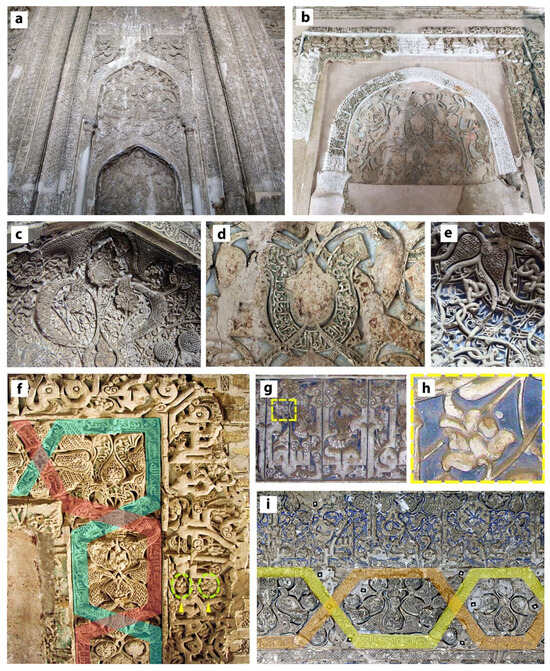
Figure 14.
Comparison of two undated stucco decorations (photos: A. Shekofteh): (a) stucco decoration of Gonbad-i ʿAlaviyān; (b) stucco decoration of Sujās Jamaʿ Mosque; (c) lunette of the Gonbad-i ʿAlaviyān mihrab, showing three layers: arabesque (first layer), floriated Khatāʾī (second layer), and an isolated Khatāʾī motif (third layer); (d) lunette of the Sujās Jamaʿ Mosque mihrab, lacking Khatāʾī motifs in the background (third layer); (e) lunette of the Ḥeydariya Madrasa mihrab, similar in design to Sujās and likewise without Khatāʾī motifs in the background; (f) lotus blossom motifs of the Sujās Jamaʿ Mosque (yellow arrows), comparable to those of the Ḥeydariya Madrasa (g,h); (g) Kufic inscription of the Ḥeydariya Madrasa; (h) magnified view of a lotus blossom (the yellow rectangle) in (g); (i) two entwined inscriptions in the margin of the mihrab of Ḥeydariya Madrasa are highlighted with different strips of color, comparable to the inscription design in the Sujās Jamaʿ Mosque mihrab, shown in different strips of color (f).

Table 6.
Comparative table of two case studies based on the Ilkhanid style.
The Jamaʿ Mosque of Sujās, located in the village of Sujās near Zanjan in northwestern Iran (Figure 3), is a hypostyle mosque of modest scale that preserves important evidence of medieval stucco decoration. The building consists of a rectangular prayer hall articulated by brick piers and covered with simple vaulting, reflecting the straightforward architectural forms typical of small congregational mosques. Its mihrab, however, is richly adorned with stucco ornament, including inscriptions and vegetal motifs, though with a less complex layering compared to major urban monuments of the Ilkhanid period31. The mihrab underwent two phases of decoration32 and does not fully exhibit Ilkhanid characteristics. For instance, the main coverage of the surfaces is not stucco. The mihrab’s primary inscription is foliated Kufic rather than thuluth, its lunette consists of two layers of arabesque and curved inscriptions without floriated Khatāʾī, and Bannāī is absent as a third layer (Table 6).
Two entwined inscriptions of Tawqiʿ33 of Sujās Jamaʿ Mosque were also identified in the margin of the mihrab of Ḥeydariya Madrasa (Figure 10). Tawqiʿ is not a common script in Ilkhanid stucco; a version of thuluth similar to Tawqiʿ has been identified in just two monuments from the Ilkhanid period [73]. Certain features, such as the high-relief margins and lateral inscriptions in Kufic and Tawqiʿ, echo the designs of the Ḥeydariya Madrasa, which are attributed to the late Seljuq [68]. Underlying plant motifs, including spiral plants and lotus blossoms34, further suggest a Seljuq influence. Although Sujās is geographically closer to Solṭāniyya (Figure 3), a major Ilkhanid center, its decorative features align more closely with the Qazvin style, which retained strong Seljuq characteristics. This stylistic affinity indicates that the Sujās mihrab reflects continuity of Seljuq traditions rather than Ilkhanid influence. Consequently, the Sujās mihrab is most likely attributable to the late Seljuq period, despite some superficial similarities to Ilkhanid decoration.
The case of Gonbad-i ʿAlaviyān demonstrates that when many features correspond to the stylistic idioms identified in this study, its dating may reasonably be reconsidered. By contrast, the example of Sujās Jamaʿ Mosque shows that when Ilkhanid characteristics are not clearly present, multiple factors—motifs, inscriptions, techniques, and overall composition—must be evaluated in combination to establish the historical period. These cases underscore the importance of considering regional stylistic and regional workshop variations, as northern Iranian centers (e.g., Qazvin and Zanjan, including the Solṭāniyya dome) exhibit different features from those of Greater Khorasan (e.g., Jamaʿ Mosque of Faryoūmad, Bayazid-i Basțāmi complex) and from Isfahan and Yazd (e.g., Pir-i Bakrān mausoleum, Jamaʿ Mosque of Isfahan) [78,79]. Inscription styles likewise vary regionally, with certain scripts appearing only in Greater Khorasan and being absent in other provinces. Future research could investigate the provenance of these scripts, particularly Tawqiʿ, which use in Seljuq architectural decoration—as an early stage in the development of thuluth—remains uncertain. Therefore, while the present study offers a preliminary framework for identifying Ilkhanid stucco decorations, more detailed investigations are required to refine stylistic criteria.
6. Conclusions
Stucco decoration reached a peak of technical and artistic sophistication during the Ilkhanid period, when it came to cover nearly all architectural surfaces, particularly in interior design. Large expanses such as iwāns and walls were generally treated with simpler patterns such as Bannāī or Shebh-i Ājori, while the qibla walls and mihrabs became the primary sites for elaborate and innovative designs. Ilkhanid craftsmen developed highly sophisticated methods, most notably the Seh-gacha (very high-relief) technique, which allowed for superimposed three-plane compositions of remarkable depth and complexity. New techniques such as Patta (molded), Moshabbak (reticulated), and gilding were also introduced, significantly enhancing the visual richness of stucco ornament.
In terms of design, Ilkhanid stucco was characterized by multilayered compositions in which arabesques, Khatāʾī motifs, and inscriptions were interwoven in increasingly intricate arrangements. Inscriptions, in particular, assumed a central role in decoration: alongside foliated, braided, and knotted Kufic, both Bannāī and innovative forms of thuluth—including the so-called Mosalsal—were widely employed. Geometric ornamentation was equally prominent, ranging from isolated six- and eight-point star patterns to three- and six-point Āazhede-kāri grids filled with floral or vegetal motifs. The combined refinement of technique and design gave rise to a distinctive and unrepeatable Ilkhanid idiom, one that differs markedly from both earlier Seljuq and later Timurid stucco traditions.
While the present study establishes a preliminary set of criteria for identifying Ilkhanid stucco, as the case studies of Gonbad-i ʿAlaviyān and Sujās Jamaʿ Mosque show, further detailed investigation is necessary to refine these findings. Future research must address the chronological evolution of decorative works, the history and transmission of motifs, carving and relief-shaping methods, the role of individual workshops, and the type, content, and placement of inscriptions. Such studies will not only enhance the precision of dating but also deepen our understanding of the Ilkhanid contribution to the technical and aesthetic development of Islamic architectural ornament.
Scientific investigation could also be used as a complementary method to chronological evolution studies. Scientific research could benefit from the application of non-invasive analytical techniques to investigate the material composition and stratigraphy of stucco decorations. Where appropriate, the collection of small, targeted samples for laboratory analyses could further elucidate the composition of plasters, pigments, and binding media. Such approaches would not only help differentiate regional workshops and chronological phases but also provide valuable insights into manufacturing practices, including plaster preparation, layering sequences, carving methods, and surface treatments. This combined material and technological perspective would clarify both similarities and divergences in stucco production between the Seljuq, Ilkhanid, and subsequent periods.
Funding
This research received no external funding.
Data Availability Statement
The raw data supporting the conclusions of this article will be made available by the author on request.
Conflicts of Interest
The author declares no conflicts of interest.
Notes
| 1 | Two main techniques of stucco decoration have been identified through stylistic studies. During the early Nasrid period (1238–1314), stucco was carved in situ with chisels while the gypsum was still damp. The decorative programs of the Alhambra from this phase are comparatively simple and less labor-intensive. Later, a plaster-cast technique was introduced, in which stucco was molded in Plaster of Paris, clay, or wooden molds and subsequently affixed to the walls. By the late Nasrid period, working methods had become more systematized, with casts employed to produce increasingly complex decorative motifs [5]. This Arabic-derived style of stucco decoration in Andalusia was further disseminated by the Moors and became known as the mudéjar style, which flourished in Spain from the thirteenth to the fifteenth centuries [6]. |
| 2 | Dar-jā (درجا) in Persian |
| 3 | In Islamic thought, two key considerations are closely intertwined: (i) the rejection of images that might be perceived as idols—most notably representations of humans or animals, especially within mosques, where only very rare depictions of birds or quadrupeds are observed; (ii) the broader prohibition of figural representation of living beings. It should be noted, however, that this attitude was not universally or uniformly imposed. For instance, human figures appear somewhat more frequently in Shiʿi contexts than in Sunnite ones [13,14]. Moreover, Islamic principles also discouraged the use of excessive luxury in art, as it was seen as a violation of the sanctity of religious values [15,16]. |
| 4 | Some scholars argue that Byzantine and Islamic artistic borrowings from the Sasanians were part of a broader pattern of emulating Sasanian imperial practices, reflecting admiration for an empire that epitomized oriental luxury and political authority. In fact, it was primarily the late Sasanian stylistic features that disseminated into Islamic artistic realms [18,19,20]. |
| 5 | In miniaturistic compositions, a greater number of elements are required to fill similar spaces, making such works more labor-intensive and painstaking than their monumental counterparts. |
| 6 | Accession Number: 40.170.441, https://www.metmuseum.org/art/collection/search/450114 (accessed on 1 November 2022). |
| 7 | Du-gacha (دو گچه) is a technique of using two gypsum layers to make high-relief decoration. |
| 8 | Movaraq Kufic (کوفی مورق): The bifurcation of letter endings, often forming half-palmettes, is one of the most striking features among the varieties of Kufic script. These varieties include primitive (simple) Kufic, foliated Kufic, floriated Kufic, plated or interlaced Kufic, knotted Kufic, bordered Kufic, Bannāī (angular Kufic), and Maʿqely Kufic (rectangular or square Kufic) [46,47]). |
| 9 | Āazhede-kāri (آژده کاری): Repetitive simple geometric shapes like a honeycomb. |
| 10 | Stamped joint plugs are observed on nearly all surfaces, from the lower layers of brick masonry up to the apex of the dome. In some areas, wider joints are filled with more elaborate motifs, such as knots or plaited bands, while the fundamental brick-bonding pattern remains dominant. In mihrabs, stucco ornamentation becomes more prominent and exhibits greater freedom, with tendrils and fleurons in relief filling the spaces between the letters of inscriptions [48]. Notably, the practice of filling spaces between the letters of brick inscriptions with stucco fleurons predates the Seljuq period, as seen in the Kufic band of the octagonal pavilion of Shaykh ʿAbd al-Ṣamad in Natanz, attributed to the Buyid era. |
| 11 | Khatāʾī (ختایی): Floral patterns added to the arabesque to create lavish designs. |
| 12 | Qaṭār-bandy (قطاربندی): A circuit frieze of inscription inside maqṣura (dome chamber). |
| 13 | Pishāny (پیشانی) is a decorative frame above the mihrab, directly beneath the roofline of the maqṣura, serving as both an ornamental feature and a transitional element between the vertical surface of the mihrab and the overhead architectural framework. |
| 14 | Gach-o-Khak (گچ و خاک) is a specific mixture of clay and gypsum to level the substrate before executing the decoration on the wall. |
| 15 | Gach-i Tiz (گچ تیز) is quick-setting gypsum. |
| 16 | Yek-gacha (یک گچه) is a technique using a single gypsum layer to make a low-relief decoration. |
| 17 | Gach-i Khoush-maya (گچ خوش مایه). |
| 18 | Seh-gacha (سه گچه) involves using three gypsum layers to make a very high-relief decoration. |
| 19 | Kaluk-band (کلوک بند) is a method to decorate the vertical distance between the bricks of a row. |
| 20 | Shebh-i Ājori (شبه آجری) is composed of the brick-like cladding of the wall, which is executed by gypsum. |
| 21 | Godard produced the first reports on the stucco decoration of Pir-i Ḥamze Sabzpūsh, which has been attributed to the sixth century AH [63]; Pope also noted the similarity of this mihrab to the stucco decoration of Gonbad-i ʿAlaviyān, Hamedan [23]. The mihrab’s inscription is damaged but partially legible, “فی المحرم… …ﻌین و خمسمائه”, with the probable date reading “تسعین و خمسمائه” (590 AH; 1194 CE). Scholarly consensus suggests that the decorations belong to two distinct periods: the sixth and eighth centuries AH [64]. According to these authors, the upper panel of the mihrab, which includes Moshabbak decoration, dates to the eighth century AH, as it is set apart from the margin of the mihrab and differs in both design and execution. The underlying white paint layer, associated with the first phase of decoration, is located beneath the mihrab near its cornice [64,65] |
| 22 | The earliest dated inscription of the mihrab is 363/974 (Deylamid period), although Godard considered the mosque to be of even earlier origin [66]. The mihrab appears to have undergone several phases of restoration and reconstruction, as evidenced by additional dates: 460/1068 (Seljuq), 560/1165 (Khwarazmian), and another now-destroyed inscription that is no longer legible. Surrounding the mihrab is also a thuluth inscription dated 946/1540. Beyond the mihrab itself, inscriptions elsewhere in the mosque attest to further interventions, particularly during the Safavid and Qajar periods. Despite this epigraphic evidence, the precise dating of each structural or decorative phase of the mihrab remains uncertain—especially the inner lunette, which features reticulated decoration. From a stylistic perspective, this reticulated element cannot be earlier than the Khwarazmian period, and in fact, its design bears closer affinity to Safavid ornament. |
| 23 | The dating of the mihrab of Yahya va Fażl-al-Reżā remains a matter of scholarly debate. An inscription at the base of the mihrab reads: “فی ایام امیرالمومنین رضی الله عنه سنة ثلثین”. Taken literally, this would correspond to 30 AH; however, such a date is implausible, since the use of the thuluth script had not yet been developed at that time. Some scholars suggest that the word “ثلثمائه” (three hundred) may have been partially destroyed in the inscription, which would instead yield a date of 330 AH [67]. By contrast, Wilber proposed a much later date of 708 AH [1]. Further evidence comes from the builder’s signature, “عمل حسن علی احمد بابویه”, inscribed on the mihrab. Scholars generally associate this name with the Babuya family, who are attested in contemporary architectural contexts, including the Shaykh ʿAbd al-Ṣamad Monastery (707/1308) and the luster mihrab now in the Metropolitan Museum of Art (eighth/fourteenth century) [68]. On this basis, most experts assign the mihrab of Yahya va Fażl-al-Reżā to the eighth/fourteenth century [69]. |
| 24 | Noqul (نغول) is the name of a small, circular, projecting ornament on the mihrab in Persian. |
| 25 | Moʿaraq (معرق) consists of small pieces of polychrome tile carefully fitted together to form a figure or inscription, in a manner comparable to mosaic. |
| 26 | Including Iran, Egypt, North Africa, Spain (Al Andalus), Iraq, Syria, Palestine, the Indian Subcontinent, Turkey, Central Asia, and Anatolia. |
| 27 | Bannāī (بنایی) is a kind of angular Kufic script that has geometric letters like squares, rhombuses, rectangles, and parallel and crossed lines [47]. |
| 28 | Reqāʿ (رقاع) is one of the six Islamic calligraphies that was often used on a small scale [47]. |
| 29 | Scholars believe that this building corresponds to the first half of the sixth century AH in terms of its external structure and plan, representing a Seljuq-based design given the type of brick decoration used [23,26,74]. |
| 30 | Herzfeld has estimated the date of this building as being between 709 and 716 AH (1310–1317) [75]. In addition, Wilber estimated that the interior decoration was probably added in the next period, and its date is 715 AH (1316) due to the elegance, beauty, and prominence of the motifs, which are characteristic of the patriarchal beds [1]. |
| 31 | According to the style and inscriptions beside the lotus flowers on the mihrab of Sujās, it is attributed to the eighth AH century [76]. |
| 32 | The first phase is attributed to the Seljuq period, given the style of its building, and the second phase is attributed to the later thirteenth century [70]. |
| 33 | Tawqiʿ (توقیع) is one of the six Islamic calligraphies deriving from thuluth. Its shape and appearance are conclusive evidence that it is a derivative of thuluth [47]. |
| 34 | This lotus flower is a preliminary design of the Shāh Abbāsi flower, or “Goljam”, which is formed in Khatāʾī twirl [77]. |
References
- Wilber, D.N. The Architecture of Islamic Iran: The Ilkhanid Period; Greenwood press: Westport, CT, USA, 1955; pp. 7–30. [Google Scholar]
- Sheila, B. The Mongol Capital of Sulṭāniyya, ‘The Imperial’. Iran 1986, 24, 139–151. [Google Scholar]
- Piran McClary, R. Three Ilkhanid Stucco Mihrabs in Central Iran: Work of a Distinctive Regional Workshop? In Stucco in the Islamic World, Studies of Architectural Ornament from Spain to India; Richard, P., Ed.; Edinburgh University Press: McClary, Scotland, 2025; Chapter 12; pp. 239–260. [Google Scholar]
- Grbanovic, A.M. The Ilkhanid Revetment Aesthetic in the Buqʿa Pir-i Bakran: Chaotic Exuberance or a Cunningly Planned Architectural Revetment Repertoire? Muqarnas Online 2017, 34, 43–83. [Google Scholar] [CrossRef]
- Cardell-Fernández, C.; Navarrete-Aguilera, C. Pigment and plasterwork analyses of Nasrid polychromed lacework stucco in the Alhambra (Granada, Spain). Stud. Conserv. 2006, 3, 161–176. [Google Scholar] [CrossRef]
- Hattstein, M.; Delius, P. Islamic Art and Architecture; Tandem Verlag: Cologne, Germany, 2010. [Google Scholar]
- Rubio Domene, R. Yeserías De La Alhambra: Historia, Técnica y Conservación; Universidad de Granada: Granada, Spain, 2010; pp. 194–200. [Google Scholar]
- Wulff, H.E. The Traditional Crafts of Persia; MIT Press: Cambridge, MA, USA, 1966. [Google Scholar]
- Erich FSchmidt Persepolis, I. Structures, reliefs, inscriptions. J. Am. Orient. Soc. 1957, 77, 145–198. [Google Scholar] [CrossRef]
- Baltrusaitis, J.; Sasanian Stucco, A. Ornamental. In A Survey of Persian Art from Prehistoric Times to the Present; Pope, A.U., Ackerman, P.H., Eds.; Oxford University: Oxford, UK, 1938; pp. 601–630. [Google Scholar]
- Harper, P.O. Art in Iran, History of Sasanian. In Encyclopaedia Iranica; Yarshater, E., Ed.; Routledge & Kegan Paul: Oxfordshire, UK, 1986; Volume II, pp. 585–594. [Google Scholar]
- Kharazmi, M.; Afhami, R.; Tavoosi, M. A Study of Practical Geometry in Sassanid Stucco Ornament in Ancient Persia. Nexus Netw. J. 2012, 14, 227–250. [Google Scholar] [CrossRef]
- Riefstahl, R.M. Persian Islamic Stucco Sculptures. Art Bull. 1931, 13, 439–463. [Google Scholar] [CrossRef]
- Grabar, O. The Formation of Islamic Art; Revised and Enlarged Edition; Yale University Press: London, UK, 1987; pp. 136–149. [Google Scholar]
- Ismāʿīl, R. al-Fārūqī. “Islām and Art.” Stud. Islam. 1973, 37, 81–109. [Google Scholar]
- Soganci, I.O. Islamic aniconism: Making sense of a messy literature. Marilyn Zurmuehlen Work. Pap. Art Educ. 2004, 1, 1–8. [Google Scholar] [CrossRef]
- Heidemann, S.; de Lapérouse, J.F.; Parry, V. The Large Audience: Life-Sized Stucco Figures of Royal Princes from the Seljuq Period. Muqarnas 2014, 31, 35–71. [Google Scholar] [CrossRef]
- Corsi, A.L. A Brief Note on Early Abbasid Stucco Decoration. Madinat al-Far and the First Friday Mosque of Isfahan. Muqarnas 2017, 25, 83–95. [Google Scholar] [CrossRef]
- Bromberg, C.A. Sasanian Stucco Influence: Sorrento and East-West. Orient. Lovan. Period. 1983, 14, 247–267. [Google Scholar]
- Haase, C.P. The Development of Stucco Decoration in Northern Syria of the 8th and 9th Centuries and the Bevelled Style of Samarra. Facts Artefacts 2007, 439–460. [Google Scholar]
- Ahmadi, H.; Shekofteh, A. The Stucco Decoration in Early Periods of Islamic Architecture in Iran (seventh to eleventh centuries AD). J. Lit. Relig. Art 2011, 4, 125–150. [Google Scholar]
- Flury, S. Un monument des premiers siècles de l’Hégire en Perse: II. Le décor de la mosquée de Nâyin. Syria 1921, 2, 305–316. [Google Scholar] [CrossRef]
- Pope, A.U.; Ackerman, P. A Survey of Persian Art from Prehistoric Times to the Present; Soroush Press: Tehran, Iran, 1964; Volume 3, pp. 1264–1364. [Google Scholar]
- Shekofteh, A. Comparative Study on the Stucco Decorations of Two Monuments from the Greater Khorasan: Robat Sharaf and Faryoūmad Mosque (Seljuq, Khwarazmian, The Ilkhanid). Negareh J. 2019, 14, 101–121. [Google Scholar]
- Shekofteh, A. Study on the Evolution of Stucco Ornaments in Architecture of Iran, the First Part of the Encyclopedia of Iran Architecture’s Decorations; Research Institute of Cultural Heritage & Tourism: Tehran, Iran, 2018. [Google Scholar]
- Aghajani, I.; Korn, L. Stucco of the Seljuq Period in Iran, with a Focus on Dado Zones and Mihrabs. In Stucco in the Islamic World: Studies of Architectural Ornament from Spain to India; Edinburgh University Press: Edinburgh, UK, 2025; pp. 197–222. [Google Scholar]
- Taqavinejad, B. The Comparative Study of Geometric Ornaments of Plaster Mihrabs Created during Seljuk Period versus the Ones Created during Ilkhanid Period in Iran. Maremat Me’mari-E Iran 2019, 9, 21–40. [Google Scholar]
- Grube, E.J. Studies in the Decorative Arts of the Muslim World; Pindar Press: London, UK, 2006. [Google Scholar]
- O’kane, B. Studies in Persian Art and Architecture; Amer University in Cairo Press: Cairo, Egypt, 1995. [Google Scholar]
- Pope, A.U. The Historic Significance of Stucco Decoration in Persian Architecture. Art Bull. 1934, 16, 321–332. [Google Scholar] [CrossRef]
- O’kane, B. Naṭanz and Turbat-i Jām. Stud. Iran. 1992, 21, 85–92. [Google Scholar] [CrossRef]
- Zarei, M.E.; Mortazaei, M.; Behboodi, N.; Thani, L. An Analytical view on the Stucco Decorations of the Ilkhanid Religious Buildings: A Case Study of Pir-i Bakran Isfahan, Iran. Iran. J. Archaeol. Stud. 2012, 2, 95–108. [Google Scholar]
- Shekofte, A. The Most Significant Visual Characteristic in Stucco Decorations, Ilkhanid Architecture of Iran. J. Iran. Archit. Stud. 2013, 1, 79–98. [Google Scholar]
- Shekofte, A.; Salehi Kakhki, A. Techniques and changes of stucco decorations in Iranian architecture from 7th to 9th century Hijry Qamari. Negareh 2014, 9, 63–81. [Google Scholar]
- Alvandiyan Khakbaz, E. Identification of the unique stucco technique of the Ilkhanid tomb. Seyyed Rokn Al din Yazd. Master’s Thesis, Department of Conservation, Art University of Isfahan, Isfahan, Iran, 2005, unpublished. [Google Scholar]
- Taqavinejad, B. Typology of the Form and the Role of the Frames Covered in the Stucco Decorations Made during 8th Century in Iran. Maremat Me’mari-E Iran 2020, 10, 13–26. [Google Scholar]
- Salehi Kakhki, A.; Aslani, H. Presentation of 12 types of stucco works used in the architectural decoration of the Islamic period in Iran based on technical properties. J. Archaeol. Stud. 2011, 3, 89–106. [Google Scholar]
- Aslani, H. Technical Studies of Stucco Decoration on the Islamic Era. Ph.D. Thesis, Department of Conservation, Art University of Isfahan, Isfahan, Iran, 2012, unpublished. [Google Scholar]
- Hamzavi, Y.; Aslani, H. Arayiha-Yi Miʿmari-yi Buqʿa-yi Pir-I Bakran; Goldasteh: Isfahan, Iran, 2012. [Google Scholar]
- Goldman, B. The Allover Pattern in Mesopotamian Stuccowork. Berytus Archaeol. Stud. 1952, 10, 13–20. [Google Scholar]
- Thompson, D. Stucco from Chal Tarkhan-Eshqabad near Rayy; Aris & Phillips Ltd.: Warminster, UK, 1976. [Google Scholar]
- Keall, E.J. Qalʿeh-i Yazdigird: A Sasanian Palace Stronghold in Persian Kurdistan. Iran 1967, 5, 99–121. [Google Scholar] [CrossRef]
- Keall, E.J.; Leveque, M.A.; Willson, N. Qal’eh-i Yazdigird: Its Architectural Decorations. Iran 1980, 18, 1–41. [Google Scholar] [CrossRef]
- Shani, R. On the Stylistic Idiosyncrasies of a Saljūq, Stucco Workshop from the Region of Kāshān. Iran 1989, 27, 67–74. [Google Scholar] [CrossRef]
- Ekhtiar, M.; Soucek, P.; Canby, S.R.; Haidar, N.N. Masterpieces from the Department of Islamic Art in the Metropolitan Museum of Art; The Metropolitan Museum of Art: New York, NY, USA; Yale University Press: New Haven, CT, USA, 2011; p. 101. [Google Scholar]
- Grohmann, A. The Origin and Early Development of Floriated Kūfic. Ars Orient. 1957, 2, 183–213. [Google Scholar]
- Fazaeli, H. Aṭlas-i khat; Calligraphy Atlas; Enteshārāt-i Mash’al: Isfahan, Iran, 1983. [Google Scholar]
- Korn, L. Architecture and Ornament in the Great Mosque of Golpāyegān (Iran). Beiträge Zur Islam. Kunst Und Archäologie 2012, 3, 212–236. [Google Scholar] [CrossRef]
- Shekofteh, A.; Ahmadi, H.; Oudbashi, O. Architectural Decorations from Seljuq Period in Iran and Their Impact on the Maintenance of Culture in Further Historical Periods; Research Report; Centre of Traditional Arts of Islam, the Institute of Culture, Art and Communication: Isfahan, Iran, 2012. [Google Scholar]
- Shekofteh, A.; Ahmadi, H.; Oudbashi, O. Seljuk Brickwork Decorations and Their Sustainability in Khwarezmid and Ilkhanid Decorations. Univ. Sci. Technol. 2015, 3, 84–104. [Google Scholar]
- Korn, L. Iranian Style ‘Out of Place’? Some Egyptian and Syrian Stucco of the 5–6th/11–12th Centuries. Ann. Islam. 2003, 37, 237–260. [Google Scholar]
- Taqavinejad, B. The study of the plant and geometric decorations of the stucco mihrabs of the tomb of Torbat-e Sheikh-e Jam. Negarineh Islam. Art 2017, 4, 17–31. [Google Scholar]
- Taqavinejad, B. Introducing and Reviewing the Decorative Features of the Mihrab of the Great Mosque of Saveh in Arak Chaharfasl Museum. Negarineh Islam. Art 2018, 5, 4–14. [Google Scholar]
- Salehi-Kakhki, A.; Taqavinejad, B. Introduction and Typology of Geometric Decorations in the Architectural Ornaments of the Dome of Sultaniyya. JIAS 2020, 9, 165–178. [Google Scholar]
- Taqavinejad, B.; Mirsalehian, S. Geometric decorations in the architectural of Varamin Mosque. Rahpooye-E Honar 2022, 5, 29–39. [Google Scholar]
- Salehi Kakhki, A.; Taqavinejad, B. The typology of plant compositions in the Iranian stucco decoration from the Islamic period to the end of the eighth century AH. J. Res. Islam. Archit. 2019, 6, 39–56. [Google Scholar]
- Mishmastnehi, M.; Van Driessche, A.E.; Smales, G.J.; Moya, A.; Stawski, T.M. Advanced materials engineering in historical gypsum plaster formulations. Proc. Natl. Acad. Sci. USA 2023, 120, e2208836120. [Google Scholar] [CrossRef] [PubMed]
- Motififard, M.; Fotohi, P. Plastering: Reviving Forgotten Arts; Naqsh-e Mana: Tehran, Iran, 2012. [Google Scholar]
- Degeorge, G.; Porter, Y. The Art of the Islamic Tile; Flammarion: Paris, France, 2002. [Google Scholar]
- Heydari, F. Technological Study of a Type of Stucco Decorations Under the Soltaniyeh Dome. Master’s Thesis, Faculty of Restoration and Conservation, Art University of Isfahan, Isfahan, Iran, 2012, unpublished. [Google Scholar]
- Brambilla, M. Pre-fabricated Stucco Decorations in Sultaniyya. In Proceedings of the International Conference of Stucco Decoration in the Architecture of Iran and Neighbouring Lands, Bamberg, Germany, 4–7 May 2022; “Bamberg” University: Bamberg, Germany, 2022. [Google Scholar]
- Isfahani-pour Hanzaei, F. Technological Study, Condition Assessment, and a Conservation Plan for Stucco Decorations in Shamsiyeh School, Yazd. Master’s Thesis, Faculty of Conservation and Restoration, Art University of Isfahan, Isfahan, Iran, 2011. [Google Scholar]
- Godard, A.; Godard, Y.; Siroux, M. Aṯhār-e-Irān; trans. Abul Hasan Sarv-qad Moqadam; Astan-e-quds-Razavi publication: Mashhad, Iran, 1992. [Google Scholar]
- Karimy, A.H.; Holakooei, P. Analytical studies leading to the identification of the pigments used in the Pīr-i Hamza Sabzpūsh Tomb in Abarqū, Iran: A reappraisal. Period. Di Mineral. 84 2015, 3A, 389–405. [Google Scholar]
- Fadawi, S.M.; Zareʿ, H. Pīr-i Hamza Sabzpūsh. Honar-Ha-Ye-Ziba Honar-Ha-Ye Tajassomi 20 2015, 1, 25–38. [Google Scholar]
- Zakeri, M.H.; Memarian, G.H. Jamaʿ Mosque of Neyriz. Honar-Ha-Ye-Ziba 2006, 24, 67–69. [Google Scholar]
- Feiz-e Qomi, A. Ganjine Athar-i Qom; Mihr Ostovar: Qom, Iran, 1970. [Google Scholar]
- Hillenbrand, R. Salǧūq Monuments in Iran: I. Orientral Art 1972, 18, 1–14. [Google Scholar]
- Blair, S. A Medieval Persian Builder. J. Soc. Archit. Hist. 45 1986, 4, 389–395. [Google Scholar] [CrossRef]
- Taqavinejad, B. The Ornaments of Ilkhanid Stucco Mihrabs of Iran Stylistic Characteristics on the Basis of Composition and Motifs. Ph.D. Thesis, Faculty of Conservation and Restoration, Art University of Isfahan, Isfahan, Iran, 2017, unpublished. [Google Scholar]
- Abdullahi, Y.; Rashid Bin Embi, M. Evolution of Islamic geometric patterns. Front. Archit. Res. 2013, 2, 243–251. [Google Scholar] [CrossRef]
- Hillenbrand, R. Salǧūq Monuments in Iran. V. The Imāmzāda Nūr, Gurgān. Iran 1987, 25, 55–76. [Google Scholar] [CrossRef]
- Shekofteh, A. The Content of Quranic Inscriptions Used in Ilkhanid Altars. JRIA 2015, 3, 104–120. [Google Scholar]
- Hatam, Q.A. Islamic architecture of Iran in the Seljuq period; Jahad-i dāneshgāhi Publications: Tehran, Iran, 2000. [Google Scholar]
- Herzfeld, E. Die Gumbadh-i ʿAlawiyyan und die Baukunst der Ilkhāne in Iran. In A Volume of Oriental Studies Presented to Edward G. Browne, on His 60th Birthday (7 February 1922); Arnold, T.W., Nicholson, R.A., Eds.; Cambridge University Press: Cambridge, UK, 1922; pp. 186–199. [Google Scholar]
- Hillenbrand, R. Salǧūq Monuments in Iran: III: The Domed Masǧid–I Ǧāmiʿ At Suǧās. Kunst Des Orients 10 1975, 1/2, 49–79. [Google Scholar]
- Kühnel, E. Arabesque and Khatāī, Shāh Abbās Flowers: A View on the Historical Background of Three Decorative Paintings; trans. Shahryar Maleki, Hadi Aqdasiye and Hossein Taherzade-Behzad (in Persian). Yasavouli: Tehran, Iran, 1990. [Google Scholar]
- Salehi-Kakhki, A.; Taqavinejad, B. The Study of Genealogy and Individual Styles of Plaster Workers Of the 14th Century. JRIA 2017, 5, 84–104. [Google Scholar]
- Grbanović, A.M. Ilkhanid Stucco Revetments in Iran, C. 1256–1335: Function, Meaning, and Aesthetic Principles. Ph.D. Thesis, Otto-Friedrich-Universität Bamberg, Bamberg, Germany, 2023. [Google Scholar]
Disclaimer/Publisher’s Note: The statements, opinions and data contained in all publications are solely those of the individual author(s) and contributor(s) and not of MDPI and/or the editor(s). MDPI and/or the editor(s) disclaim responsibility for any injury to people or property resulting from any ideas, methods, instructions or products referred to in the content. |
© 2025 by the author. Licensee MDPI, Basel, Switzerland. This article is an open access article distributed under the terms and conditions of the Creative Commons Attribution (CC BY) license (https://creativecommons.org/licenses/by/4.0/).
